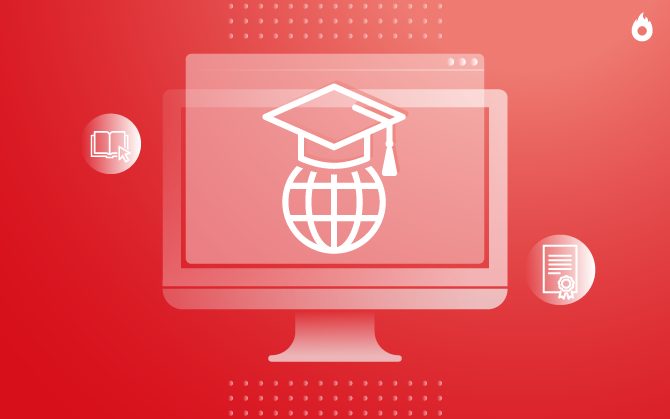
5 Teaching methodologies you need to know about
Check out 5 innovative teaching methodologies that are revolutionizing the traditional learning process

What will we see in this post
During the learning process, it’s necessary to create structures and paths that make the content more tangible and practical for students. It’s during this structuring, that teaching methodologies emerge with the goal of guiding the sharing of knowledge, working on each student’s stimuli and skills.
Currently, there are several methods that explore varied teaching plans, departing from the conventional models that only focus on expounding information and evaluations to check if the content was applied and learned.
What is a teaching methodology?
A teaching methodology is a set of methods and paths used to acquire knowledge, which also improve the quality of the knowledge being learned.
Strategies, tools, and goals are outlined, and must be followed in order to optimize the learning process and create a bridge between students and content throughout the journey.
The methodology is applied by educators and teachers in a variety of teaching formats, and there are independent techniques for each type of strategy applied.
Unlike traditional learning methods that don’t always accommodate students’ needs and goals, alternative methods are emerging that offer new, more modern, humanized, and effective structures.
With good teaching methodologies, students will feel more welcome. They’ll be able to develop their skills and acquire greater autonomy, leadership, self-confidence, and motivation. Learning something new will be more relaxed and fun.
Certain tools are widely used during the knowledge learning process, such as storytelling, gamification, case studies, DIY, debates, seminars, and blended learning.
In this post, you’ll learn about 5 modern and innovative teaching methodologies that you can put into practice!
5 teaching methodologies you need to know
1. Eduscrum Teaching Methodology
The Eduscrum teaching methodology is derived from the Scrum methodology, which is only applied to projects. Eduscrum, on the other hand, was adapted for the educational system and is a method that encourages collective work, leadership, and commitment.
Basically, the goal is to divide students into groups of 4 to develop projects together. These projects must be well defined. Within this macro-scenario, tasks and goals are divided among the participants.
Meetings must be held between the people involved, and it’s necessary to choose one person from the team to be the leader, called the Scrum Master. This leader will report back to the teacher with task progress.
Since this system has student protagonism as one of its pillars, roles should always rotate at each round of a new project. This allows everyone to have the experience of leading the group and being responsible for it.
2. Active learning methodologies
In the active methodology, the student is the protagonist of their own learning process.
With the boom of the internet and technology, one thing is undeniable: information is everywhere! The problem lies in selecting the correct information, understanding it, and truly putting it into practice.
That’s where the teacher comes in. They have the important role of guiding students during their learning journey by giving them tasks, group activities, and other activities in the form of exercises, research, and games.
Moments of debate and exchange of information are also used in this method, where the students themselves provide knowledge to other classmates.
The active system is favorable for the use of technology in education, making it an ally for the development of students’ independence and autonomy during their studies.
3. STEM method
STEM stands for science, technology, engineering and mathematics.
This teaching methodology is very innovative because it goes beyond traditional basic education. In addition to learning a subject, students understand how it has practical applications in everyday life.
Practical activities, tests, and challenges are developed so that students not only receive information, but can also execute what was learned in class in a simple manner within their own reality.
The STEM methodology enriches and improves the perception of the acquired knowledge. It works on students’ experience with the subject matter, and helps them memorize the content more easily.
4. Maker movement
Yet another methodology that works on students’ autonomy during their learning process.
The goal of the maker movement is to develop a system where students put all of their knowledge into action! It’s an extremely practical method and encourages “DIY” thinking.
With this system, it’s common to work on different disciplines within the same project. This enables students to learn about various topics while executing the project.
This methodology is used in robotics and programming, where the end goal is to create products, services, and prototypes, which is the main idea behind the maker movement.
Collective work is quite effective, since everyone can collaborate actively in the stages of the project.
5. Blended learning
Blended learning has become a popular methodology that combines face-to-face teaching with distance learning.
Nowadays, with technological advances, it’s much easier to teach using the ODL method and obtain certain benefits, such as student autonomy (they choose when to take the classes and activities), and cost reduction (the expenses with online teaching are lower).
In addition to these points, students’ performance improves because their routine has greater flexibility, and they are able to do research, assignments, and additional activities through the digital platform.
Video lessons are more objective and the environment for answering questions is implemented in a way that doesn’t hinder the educator’s performance.
With the adoption of distance learning, many students will be able to study from different places, reducing distances and making it possible for quality education to reach more places around the world.
Nowadays, schools, universities, companies, and small businesses have already adopted the blended learning system as their main methodology, adopting most of their lessons for the online format, and only using the physical format for final evaluations and project presentations.
For a more innovative teaching process
Over the years, it has become increasingly evident how important it is to find teaching methodologies that treat people as individuals, respecting their abilities, difficulties, and characteristics.
Traditional teaching methods are now obsolete, since they offer the content in the same way to all students. This not only ignores each student’s unique journey with what is being learned, but also keeps them all at the same stage.
It’s necessary to humanize processes that are more educational and share knowledge in a tangible and practical way, respecting each person’s learning pace and valuing the best that everyone has to offer.
The internet gains prominence in the subject of education. It has brought a new perspective to the subject and has presented new learning possibilities. We expect that the use of technology won’t be the exception, but that it will gain prominence in the democratization of education.
If you believe in the future of education and would like to know how to develop innovative teaching methods, read our content on decentralized education.
Read more about the future of technology here.




